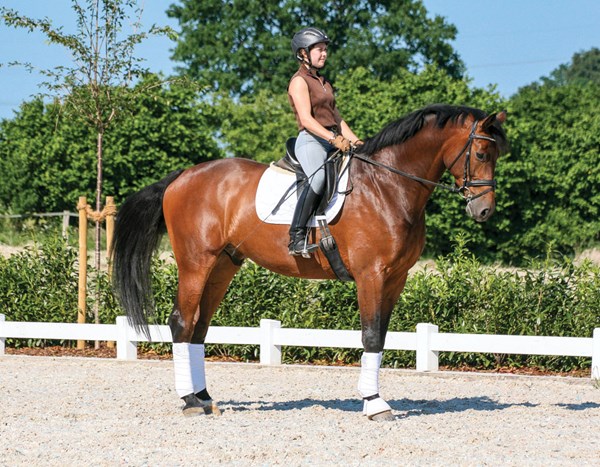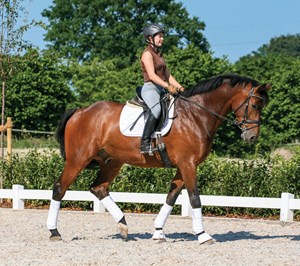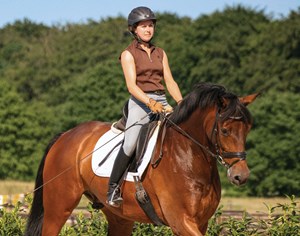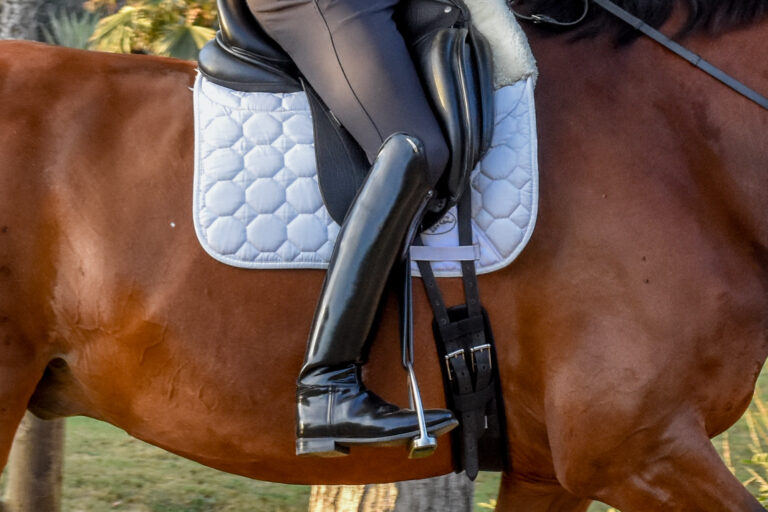The rider’s independent aids and the horse’s reactiveness to the aids go hand in hand. For example, if the rider grips with her legs like a clothespin and her seat is braced or stiff, the horse cannot hear the rider’s seat and leg.

A rider who uses constant seat or leg aids causes the horse to tune her out and have a less refined reaction to the aids. Alternatively, when the horse feels reactive and quick to the aids, then the rider can have a truly independent seat and soft, hanging legs. This reactivity is directly related to the development of the basics of dressage. To have proper rhythm, suppleness and connection the rider must not overuse aids that ultimately interfere with the horse’s balance. Lighter aids enhance the horse’s way of going.
The basic skills of dressage must always be present as the rider moves up the levels, but those skills need to be more sophisticated as she asks the horse for more difficult work. The horse’s degree of understanding and strength determine what amount of promptness the rider can demand. He should become more reactive to the aids as the rider moves up the levels. For example, a rider may be successful fulfilling the requirements on a green horse showing Training Level. But the jump from Training Level to First Level already has more necessity for promptness to the aids because of the leg yield, the lengthening and the downward transition back to the working paces. The degree of reactivity that is acceptable in First Level is not enough when trying to create more collection at Second Level. The basics remain the same and the rules don’t change, but the standards increase as you progress through the training.
If the horse doesn’t react and the rider starts kicking or gripping with the leg, then she shuts down the horse’s movement. The horse can’t feel or hear the aids. When someone is used to being talked to loudly all the time, she isn’t going to hear whispering because she is accustomed to yelling. A rider has to whisper an aid, shout a correction if needed, then whisper again. The aid shouldn’t become louder and louder.
In order for the horse to understand and react to a small aid, he needs to be trained to listen to small aids. If the horse doesn’t react, the rider makes a quiet but effective correction. There should be a difference between the correction and the aid. Then the rider tests the aid again to check that the horse understood. If the rider doesn’t retest the small aid after a correction, she has taught the horse to react only to the bigger correction.

I teach riders that there is a scale of 1 to 10 for intensity when they give an aid. If a rider gives an aid that is a 3 and her horse doesn’t respond, then she should immediately give a correction that is a 5 or 6. Then go back and retest the aid at a 3. Ideally, the horse is listening more closely and the rider will only need a 2. When the horse reacts, the rider’s seat and leg quietly follow his motion. If the rider sticks to this formula, she won’t get into the common pattern of chasing her horse off his feet in an attempt to get him more forward.
The correction could be a quick kick with the legs or a touch with the whip. Understand that the horse has to be taught to be in front of the whip the same way he is taught to be in front of the leg. He has to learn to accept the whip as a tool, not as a punishment. Touch him with the stick and teach him to go in front of it in order to help him learn to be in front of the leg. The horse should accept the whip in a quiet and respectful way.
To practice the reaction to the aids, a rider should start with the simple exercise of walk–halt–walk transitions. At the halt, she should sit relaxed, soft and still. Her legs should hang passively and be limp like a wet towel along the horse’s side. The calves of the boots are on the horse’s sides, but there is no squeezing pressure of the legs inside the boots. Then quietly ask the horse to walk off by closing the calf muscles toward the horse’s sides. This aid is a 3. When the legs are closed, the horse needs to react immediately but quietly and with relaxation. If he does not react immediately, back up the correction with a quick, tiny kick or touch with the stick. The rider’s seat and leg should remain relaxed during the correction, which is a 5. After the horse responds and is listening a little sharper, then halt again and try the 3 aid again to walk. If the correction was effective, the horse should be more reactive.
Use the same pattern in all transitions and the horse will become more reactive and feel eagerly in front of the leg, which allows the rider to sit with the quietest aids possible and, therefore, achieve harmony.

Chris Hickey has trained horses through Grand Prix. He was short-listed for the Olympics and was the winner of the individual and team gold in the 2007 Pan American Games. He holds titles for Young Horse Championships, Developing Prix St. Georges Championships and The Festival of Champions National Championships. He is based in Wellington, Florida, and Edgemoor, South Carolina.











